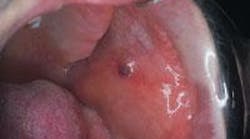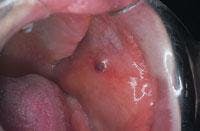By Joen Iannucci Haring
A 67-year-old female presented to a local dental office for a denture reline. During the oral examination, a bluish-purple area was noted on the buccal mucosa.
History
The patient stated that the bluish-purple swelling had been present for at least five years. When questioned about any change in color or size, the patient stated that she was unaware of any such changes. When questioned about any symptoms associated with the area, the patient claimed the lesion was painless. No history of trauma to the affected area was reported by the patient.
At the time of the oral examination, the patient appeared to be in an overall good state of health. The patient's medical history was reviewed and included an allergy to penicillin, asthma controlled by medication, and a cholecystectomy. At the time of the dental appointment, the patient reported using the anti-asthmatic drug, Theophylline.
Since the fabrication of complete dentures seven years earlier, the patient's past dental history included sporadic dental examinations. The patient's last dental appointment was approximately two years earlier for a denture reline.
Examinations
Physical examination of the head and neck area revealed no enlarged or palpable lymph nodes. The patient's vital signs were all within normal limits. No significant extraoral findings were noted.
Intraoral examination revealed a bluish-purple mass on the buccal mucosa. The mass appeared sessile and measured approximately 0.5 cm x 0.5 cm in diameter. The swelling was well-defined, soft to palpation, and exhibited a smooth surface without hemorrhage or ulceration. When pressure was applied to the swelling, blanching occurred. Further examination of the oral soft tissues revealed no other masses present.
Clinical diagnosis
Based on the appearance of the mass and the clinical information provided, which of the following is the most likely diagnosis?
o vascular malformation
o ecchymosis
o varicosity
o hematoma
o purpura
Diagnosis
• varicosity
Discussion
The varicosity (also known as the varix or varicose vein) is a common lesion that represents an abnormal vascular dilatation. A varicose vein can be defined as "an abnormally dilated, tortuous vein that is the result of prolonged, increased intraluminal pressure." Although the superficial veins of the leg are the most common sites of involvement, any vein in the body may be affected, including veins located in the oral cavity.
Clinical features
In the oral cavity, the varicosity is typically seen in older individuals, especially over the age of 50. There is no sex predilection. In older individuals, a varicosity results because of the reduced elasticity in the venous vascular wall seen as a result of aging. In the oral cavity, the varicosity is most frequently found on the ventral tongue, on the lower lip, and in the commissure region. It appears as a dome-shaped and fluctuant asymptomatic blue-purple swelling. The varicosity may vary in size depending on its location. The varicosity blanches with pressure; compression of the lesion displaces the blood from the vessel and results in a blanched appearance.
Diagnosis — The history, clinical appearance, and blanching with pressure are highly suggestive for the varicosity. The varicosity may clinically resemble the hematoma, ecchymosis, purpura, or vascular anomaly; all four of these lesions may be included in the differential diagnosis. The hematoma is a large pool of extravasated blood that results from trauma. Extravasated blood refers to blood that has been forced out of blood vessels and into the surrounding soft tissue. The hematoma appears as a dark red or blue elevated mass that is tender to the touch and fades with time. It does not blanch with pressure because the blood is not located within a blood vessel. Ecchymosis and purpura refer to bruises. These lesions represent extravasated blood that results from trauma. The ecchymosis and purpura appear as reddish-blue or purple flat lesions that may be tender to the touch and fade with time. These lesions do not blanch with pressure. The vascular anomaly is a congenital lesion. Unlike the varicosity, the vascular anomaly is present at birth and persists throughout life. The vascular anomaly blanches with pressure.
Treatment — The varicosity is a benign lesion that does not regress over time. If a varicosity is located in an area that is not an esthetic concern, it does not require treatment. In contrast, the larger lesions that present as an esthetic concern may be surgically removed.
Joen Iannucci Haring, DDS, MS, is a professor of clinical dentistry, Section of Primary Care, The Ohio State University College of Dentistry.







